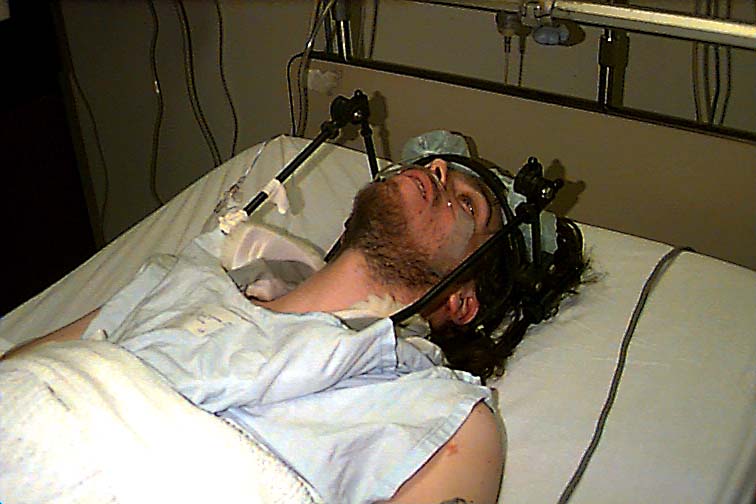 Go to Front Page
Go to Front Page  Go to Scenarios
Go to Scenarios
 Go
to Techniques
Go
to Techniques
Different Scenarios
There are numerous scenarios which may be encountered when attending an
emergency intubation on the ward or ICU. This is a description of the most
common situations that are faced and the techiques which may be appropriate
for each situation. In each sceanrio you can click on one of the available
options and be taken to a description of that technique.
Remember there may be more than one potential problem with conflicting solutions.
A judgement may need to be made as to which concern is paramount and cosideration
may have to be given to altering the procedure in view of the patients overall
condition.
Pre-oxygenate before attempting any airway maneuvers. The techniques of
jaw thrust, chin lift, head tilt and mask ventilation/assistance should
be performed to help temporize the situation. And, if the airway reflexes
are taken away, cricoid pressure
can be performed to guard against aspiration.
 Preoxygenation
Preoxygenation
Cardiac/Respiratory Arrest (A Code)
The patient is not awake, often has no blood pressure or pulse and is not
ventilating. The physician's job is to place the endotracheal tube as quickly
as possible; interrupting the code for the shortest time possible. Understanding
that obtaining an airway is paramount to a successful code. Follow the ACLS
Algorithm for each specific situation.
Techniques:
Direct laryngoscopy without
any pharmacologic aids.
The primary concern is to establish oxygenation, this initially means ventilation
with 100% oxygen by bag and mask. In this situation, the patient is not
responsive, therefore, there is no reason to use any pharmacologic adjuvants
to intubation and since the patient is not oxygenating and ventilating it
is imperative that the airway be secured as quickly as possible. Whether
the airway appears difficult or not it direct laryngoscopy can be attempted,
since this can be done quickly. This is accomplished by preparing to intubate
and than stopping CPR for the shortest time possible, securing the airway
and then allowing CPR to resume once you have confirmed tube placement.
If intubation proves difficult then stop and resume ventilation by mask.
Do not allow the patient to become hypoxic during protracted attempts to
intubate.
Cardiac (Hemodynamically) Unstable
This patient is hemodynamically compromised. You must determine the most
stable way to intubate a person in this situation. Using the inappropriate
medication may significantly compromise the patient.
Techniques:
Awake and topicalize
Sedate and topicalize
Fiberoptic
Rapid Sequence Intubation
Factors to be taken into consideration[reference
1]:
Degree of hemodynamic compromise.
Level of consciousness.
Airway evaluation.
Hemodynamic status:
1. Systolic BP less than 80 mmHg
No induction agent should be used, however, if a muscle relaxant
is to be used, an amnestic can be given for patient comfort.
Scopolamine 0.5 mg or midazolam
1-2 mg, are good amnestics and fentanyl
0.5-1.0 ug/kg is a good analgesic.
2. Systolic BP 80-100 mmHg
Small doses of thiopental
0.3-1.0 mg/kg or etomidate 0.1-0.2mg/kg
both titrated to effect. Succinylcholine
1.5 mg/kg, unless contraindicated.
3. Systolic BP greater than 100 mmHg
Thiopental 2-5mg/kg or
etomidate 0.2-0.3 mg/kg, both titrated
to effect, are effective induction agents, though etomidate is the more
hemodynamically stable of the two and would be the better choice.[reference
2]
If the airway appears normal, rapid sequence intubation would be an acceptable
intubation technique. The least cardiac depressant induction agent is etomidate
and is the best option in this situation
[reference 2]. Etomidate may still cause cardiac depression and hypotension.
If the airway did not appear normal or gave the appearance of a difficult
intubation, inducing anesthesia is no longer an option. If there are no
contraindications, sedation and topicalization would be the next option.
Midazolam can be used for amnesia.
Fentanyl can be used for analgesia. If both midazolam and fentanyl are
used, remember that they have synergistic effects on cardiac and respiratory
depression.
Increased Intracranial Pressure (ICP)
During intubation of a patient with increased ICP, any additional increases
in ICP must be avoided, adequate mean arterial pressure (MAP) is required
to maintain adequate cerebral perfusion pressure (CPP). The re is a dilemma
between reducing ICP and maintaining CPP
Techniques:
Awake and topicalize
Sedate and topicalize
Rapid sequence intubation
Topicalization may make it
difficult to adequately blunt reflexes, and coughing and bucking may occur
causing considerable increases in ICP with potentially devastating results.
Sedation may help, however, this can cause with hypoventilation and hypercapnia
with a subsequent increase in cerebral blood flow. With the increase in
blood flow there is an increase in cerebral blood volume and in a patient
who has exhausted their compensatory mechanisms this leads to an increase
in ICP.
Rapid sequence intubation with etomidate and succinycholine would be the
best choice if the airway evaluation is reasonable. Except for ketamine,
all IV induction agents decrease ICP [reference
3]. However, the dose required to decrease ICP often produces a large
decrease in MAP, this can lead to a considerable decrease in CPP. and cerebral
ischemia
Etomidate would be the induction agent
of choice in this situation, titrated to effect it can blunt the response
to laryngoscopy and intubation, but still maintain adequate CPP. Succinylcholine's
effect on ICP is controversial. There are some indications that ICP is increased
with succinylcholine use, however, this effect is minimal and transient
and can be attenuated with mild hyperventilation. Also, there has been work
that shows succinylcholine has no effect on ICP [reference
4]. The benefit gained from rapid control of the airway, especially
when there is risk of regurgitation, may outway the risk of any small increases
in ICP attributable to succinylcholine. Rapid intubation also allows earlier
institution of hyperventilation for ICP control.
Lidocaine, IV and topical, has been
shown to blunt reflexes from airway stimulation and thus control ICP [reference
5]. However, since topical lidocaine is difficult to use in this situation,
IV lidocaine [reference 6} can
be used to attenuate the airway reflexes and can reduce the ICP response
to endotracheal suctioning for up to 15 minutes.
Burns/Crush Injury/Spinal Cord Injury
In these types of injuries succinylcholine
may be contraindicated [reference 7] due the possibility of massive potassium
release.
Techniques:
Awake and Topicalize
Sedate and Topicalize
Rapid Sequence Intubation
All the non-depolarizing neuro-muscular blocking agents (NMBs) have a longer
onset time than succinylcholine. If higher doses of a nondepolaizing NMB
is given to shorten the onset of action then the duration of action is prolonged
and cardiovascular side effect or histamine release may occur (eg atracurium).
It has been said that NMBs have no place outside the OR. If a muscle relaxant
is given and intubation proves impossible, then the option of allowing the
patient to wake-up and breath spontaneously has been removed. The airway
may be lost and a surgical airway may need to be obtained.
Rocuronium may the best alternative
when succinylcholine is contraindicated. It appears to have the most rapid
onset of all the nondepolarizing NMBs.
 Go to Front Page
Go to Front Page  Go to top of Scenarios
Go to top of Scenarios  Go
to Techniques
Go
to Techniques